Electoral politics is often more perception than reality. So if PM Narendra Modi is looking slightly jaded and faded at the start of his “historic third term in office’’, it is because the optics that favoured him in the past are now working against him. The BJP is, in fact, well ensconced, with just 32 MPs short of the halfway mark and more than double the Congress party’s strength. The NDA’s tally of 293 is 21 over the halfway mark. Unlike the Vajpayee government, which was totally dependent on a mercurial Jayalalithaa, or Manmohan Singh’s regime, which was at the mercy of several ever-demanding allies, the Modi government is not reliant on any single alliance partner for survival. If it chose, it could dump political fledglings like Chirag Paswan, Anupriya Patel and Jayant Chaudhary and still survive. Yet, the perception persists.
Modi’s rather domineering style has grown over two unchallenged tenures as PM and three as the Gujarat CM. The image of wielding absolute power has both its plus and minus points. On the one hand, people appreciate a strong leader, but on the other hand, disrespect for democratic norms and the Constitution is frowned upon. Backtracking by a strong leader can also be perceived as weakness and recently, the Modi government has uncharacteristically retreated on several occasions.
Unusual U-turns
At the start of his third term, Modi gave the impression that he would continue his unilateral style of functioning. He refused to yield over the choice of the Lok Sabha Speaker, has yet to concede the Deputy Speaker’s post to the Opposition and has kept the media in Parliament at an even greater arm’s length than before. He mostly retained his old cabinet ministers and generally handed out minor portfolios to allies. Despite the outcry over the NEET exam leaks, he stood firm on not cancelling it.
But the façade of business as usual got dented after the proposed amendments to the Waqf Board Act, announced with fanfare, were dispatched to the cold storage of a joint parliamentary panel, following allies’ objections. A UPSC advertisement for lateral entries in government was hastily withdrawn after protests that it violated the reservation quota policy. The revamped pension scheme for government employees seemed yet another sop to electoral interests. A Broadcasting Bill to include online content seems to have been put on the back-burner too.
Whether Assam CM Himanta Sarma’s decision to end a colonial-era practice of a two-hour prayer break on Fridays for Muslim legislators will hold, with NDA allies already making noises, is uncertain. The proposed Waqf Board amendments and changes in the Assam legislature rules might appear fairly reasonable, but the perception of the BJP as “anti-minority” is too hot a potato for the government’s allies to defend. The censor board is dragging its feet over clearing a film produced by actor Kangana Ranaut and two FIRs for hate speeches were filed against BJP Maharashtra MLA Nitesh Rane. The Supreme Court recently criticised courts for not granting bail to the government’s political adversaries for long stretches.
The government’s backsliding is in contrast to Modi 2.0, when the PM remained implacable for months over the powerful farm Bill protests and the overwhelming demand for the removal of Brij Bhushan Singh as chief of the wrestling federation. There is a belated awareness that the government’s adamancy harmed it electorally.
Potholed road
Neither Jawaharlal Nehru and Indira Gandhi completed their last terms because of their untimely deaths. But long before their demise, they were viewed as lame duck PMs because of their flagging spirits. Modi, however, is respected for his resilience and combativeness. But can the PM change his style of functioning after over 20 years? He has to walk a fine line, projecting his image as a strong leader along with enough humility to be pragmatic when required. His unequivocal apology for the collapse of the 35-foot statue of Chhatrapati Shivaji Maharaj was a step in this direction. Normally, his short-sighted media advisers would have adopted a shrill counter attack and whataboutery as the best form of defence. With the Opposition using the caste card and minority appeasement to undermine the government, the ruling party has to tread cautiously. The RSS recently indicated it is not against caste census.
Extensive consultations before announcing a major move would be a good step for the BJP to adopt in future, along with stopping the practice of using a house-trained Enforcement Directorate to keep political rivals in check. Fickle constitutional bodies have belatedly developed a conscience, after their perception that the Central government is not necessarily here to stay. Modi stands at the crossroads in the battle of optics, with some tough Assembly polls and by-elections due in coming months, the road ahead has many potholes.

